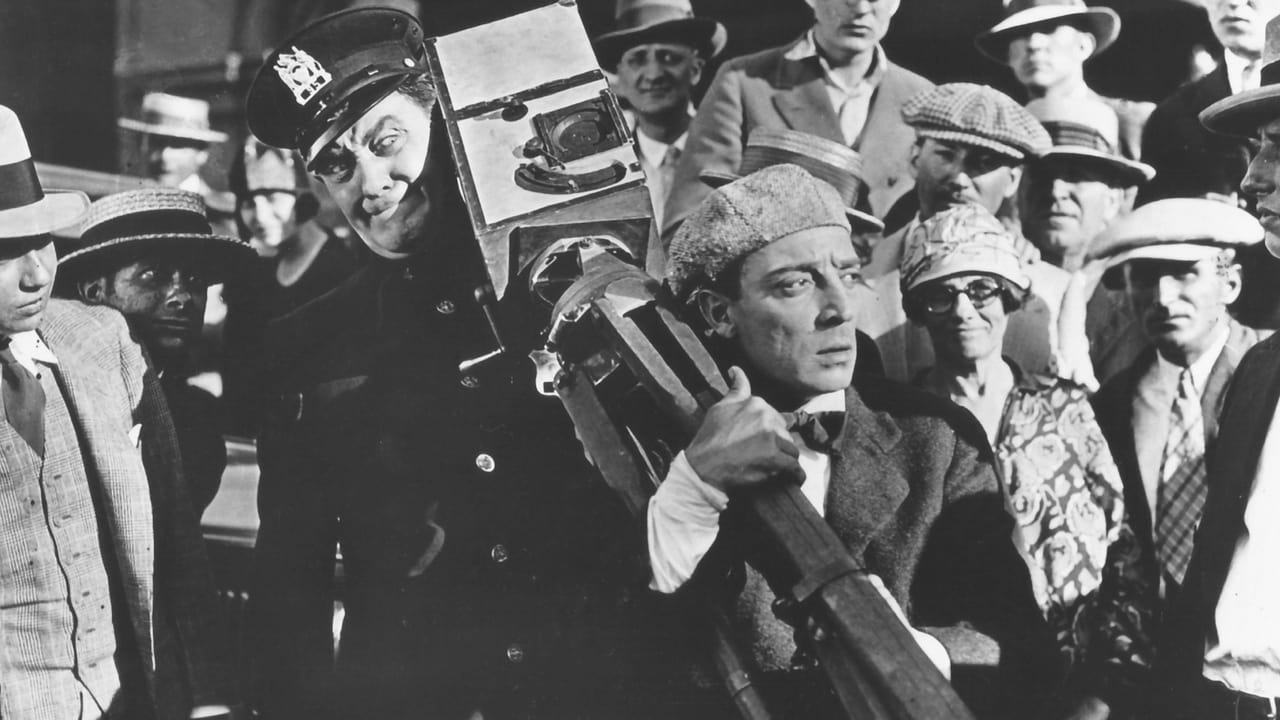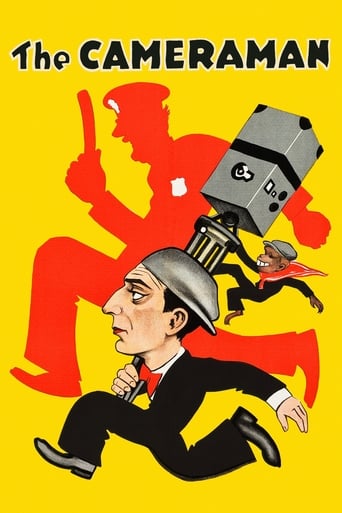

Masterful Movie
... View MoreA Disappointing Continuation
... View MoreThe film makes a home in your brain and the only cure is to see it again.
... View MoreThe movie really just wants to entertain people.
... View More1928 was a year of considerable change for film comedian Buster Keaton in more ways than one. His masterpiece "The General," hadn't been as successful at the box office as he was hoping. Keaton and his business partner went their separate ways. Buster Keaton was recommended to "M.G.M" and had no idea why the studio were interested in employing him. Regardless, he signed a contract with Louis B. Mayer and the next five years would prove to be a rather turbulent period in Keaton's life. The beginning of this period began very brightly with Keaton's final masterpiece, "The Cameraman." The story is quite a straightforward one which is a good thing in my opinion. Buster has ambitions in becoming a professional cameraman for an established New York newspaper. He is on the receiving end of derision by various people but that doesn't deter our affable hero. The leading lady of the film is the one who truly believes in Buster and is there to spur him on in achieving his ambition. There are many fine comic moments and set pieces in "The Cameraman." One of my favourites is when Buster and his date try to board a New York bus. As there is no room for any more passengers, Buster attempts to sit on the outside of the vehicle. He slips and lands hard on the concrete road. There was no camera trickery involved for this rather daring slapstick, you actually see Buster falling and landing on the road. How he didn't sustain serious injuries, I shall never know. Full credit to him for having the nerve to execute such slapstick. I enjoyed the scene where Buster imagines he is part of a baseball team at Yankee stadium. I'm surprised the comedian could cope with making a film in such a densely populated place like New York, seeing as he was nervous of large crowds. "The Cameraman" was also the last time Buster got to work with his usual gag writers, camera people, directors and other staff. They would be all be assigned to different people across "M.G.M."
... View MoreThe Cameraman (1928) is Buster Keaton's last great film, before drink and MGM's misguided stifling of his creativity effectively ended his career as a director-star. It is about an aspiring newsreel man who seeks the love of a secretary at MGM studios (a little self-promotion never hurt Leo the Lion, it seems). He looks for any kind of action to capture on the streets, contends with a slimy rival for his lady love's affections, and befriends a monkey. Like Keaton's best films, we have his sly and dry humor, action scenes, and lots of imagination.Of course, the movie differs from Keaton's pre-MGM work in key ways: it is incredibly romantic in a way Keaton avoided being in his earlier work. The love stories in some of Keaton's earlier films are fraught with misery and seem to promise little lasting happiness for both partners. Other ones are more grounded though pleasant, such as in The Navigator and The General, where Keaton's heroes end up with feisty girls who are more like comic partners than passive love objects who wait impatiently for Buster to man up and win their respect. In TC, Marceline Day is a different sort of love interest for Keaton: she is sweet, an ideal, a light in the young cameraman's seemingly dreary and lonely existence. In The General or Sherlock Jr., the young hero is lovelorn but also independent. He can live with or without love, though he's willing to fight for love at all costs. Here Buster's character lacks that kind of toughness and seems more vulnerable. This vulnerability allows Keaton to show a little more tragedy in his acting than what we normally get to see and it is fascinating. No one who has ever seen this film can forget the "descent into the sand" scene, where Buster thinks he has lost the girl of his dreams forever. The heartbreak and longing in Keaton's eyes, hands, his posture are so potent that it shocks me that viewers still call him stone-faced and cold.But don't let us forget this is a romantic comedy and there are lots of laughs to be had. It's Keaton last great silent film, a sort of walk into the sunset for his golden age.
... View MoreI understand why people want to call "The Cameraman" Buster Keaton's last silent film: It makes for a helluva swan song before a hellacious fall, not to mention a powerful and hilarious example of Buster's screen persona's drive and moxie against terrible odds."No one would ever amount to anything if they didn't try," Buster is told early on by the woman he is trying to court by taking up the job of newsreel cameraman. Telling him about his movie camera, but perhaps about life, too, she urges him: "You must always grind forward, not backward.""The Cameraman" is all about grinding forward. To make it in the newsreel business, and impress fair Sally (Marceline Day), Buster's character has to endure a lot. It's tempting to draw a connection, as one often does with Buster, between his art and his real-life situation. In 1928 he was being forced to adapt to a new way of doing things at big studio MGM, and even had to hand over the director's chair to Edward Sedgwick, though Keaton clearly contributed.In his art, if not in life, Buster could always beat the odds. That he does here is no surprise; it's the way he does it that satisfies me so. MGM wanted Buster to play more for audience sympathy, and here he manages to do so without surrendering his keen comic edge. Day was a very typical MGM ingénue in the Norma Shearer mode (Shearer herself can be glimpsed on a city billboard right after Buster falls off a bus), but she makes that work, her eyes matching Buster's for the way they absorb pain and disappointment.Comedy usually suffers when the comedian plays for the heartstrings; not this time. Buster keeps the laughs coming, from all directions. You alternately get a comedy of manners (Buster trapped in a women's drawing room) slapstick (Buster shares a dressing room with a portly grouch), sex comedy (Buster loses his bathing suit in a pool while out on a date with Sally), action comedy (Buster finds himself covering a gang war) and animal humor (a monkey named Josephine whose adoption of Buster provides the last third with a high-octane kickstart.) The only thing you don't get is a signature Keaton chase!The focus on Buster and Sally pays off, with a simple but effective plot that piles indignity after indignity upon our hero and dares him to keep grinding forward. He's so dogged it is rather funny even as it remains affecting. So lost in reverie is Buster at the prospect of a date with Sally that he walks up the staircase of his apartment building right past his apartment and to the roof. Faced with a rival at a pool, he cleverly slips Sally's kerchief out of her pocket while the two are engaged in conversation, then deftly punts the rival into the pool when the guy pauses to pick it up.Begging for a job at the newsreel office just to be close to Sally, Buster manages to break through the glass door – literally.Maybe there are times when Buster is a bit too much in his "Elmer" mode, that being the doofus character MGM stuck him with as his career progressed, and mostly regressed, though the early sound era. He doesn't seem all that bright. But the character here works to make the situation more believable, and as the film goes along, it gets much richer and deeper.Seeing the famous scene in the projection room, when Buster's final film is unspooled to three sets of hilariously divergent reactions, one is tempted to say this is Buster looking at us, his future audience, rewarding us for seeing the brilliance people in his own time too often missed. Yet Buster was no obscure talent in his own time, and "The Cameraman" was quite a hit. Buster was still riding high here, and it shows.
... View More'The Cameraman (1928)' should mark a sad occasion in the career of comedian Buster Keaton. Until then, he had created such classics as 'Sherlock Jr. (1924)' and 'The General (1927)' through his own independent production company. In 1928, however, he accepted a berth at M-G-M, and most of his creative control was taken away from him; he became a studio stooge. But this film must be an exception to that rule, because it has Keaton's footprint all over it, and is one of his finest works.Keaton plays a lowly tintype photographer who vows to become a MGM newsreel cameraman, in order to impress a pretty girl (Marceline Day). His efforts at capturing riveting news footage at first prove fruitless, as he hitches a ride aboard a firetruck that is returning back to base, and then arrives at Yankee Stadium while the team is playing in St. Louis. However, when a full-blown gang war breaks out in Chinatown, Buster is there with camera cranking (and, no joke, a monkey with a machine gun!)Keaton is well-known for his death-defying stunts, and there are a few of them here, but the film really shines in the quieter moments, as the lovelorn cameraman must accept failure at every turn: there's one unforgettable image of Keaton sitting on the beach, having been abandoned by his girl, looking completely and utterly dejected, a broken man.Despite being thought lost for decades, 'The Cameraman' has proved surprisingly influential. A crowded dressing-room farce, in which two men attempt to undress in a confined space, was likely the inspiration for a similar (and even more chaotic) scene in the Marx brothers comedy 'A Night at the Opera (1935).' Likewise, that "Mr Bean" episode where Rowan Atkinson loses his bathers in the swimming pool is a direct homage to a scene here. And Keaton humorously satirises a scene in Frank Borzage's melodrama 'Seventh Heaven (1927),' in which the characters trample up seven storeys of staircases, their movements followed by an elevator crane.
... View More